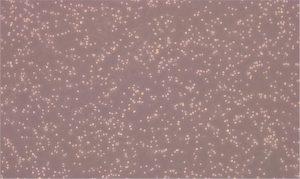Due to the global impacts of the virus, SARS-CoV-2 (COVID-19) is currently a popular topic of research. A logical experimental design to study the transmission of the disease is to model viral infection utilizing primary cells to represent the human body in an in-vitro setting. When selecting a lineage of cell for this purpose, it is important to select a product that faithfully represents a part of the body that experiences initial exposure to the virus and faithfully illustrates the responsible biology.

COVID-19 is thought to employ a liquid droplet suspended in the air as a vector.1 The most common way that these droplets enter the body is via inhalation, making cells of the respiratory tract the first barrier to internal entry for the virus. Lonza offers two products that represent these cells. Our normal normal human bronchial epithelial (NHBE) cells, are isolated from the trachea and upper bronchial tube. Alternatively, our human small airway epithelial cells (SAEC), are isolated via enzymatic digestion of the small lower airways of the lungs (bronchioles of >1 mm). SAECs include both the type-I and the type-II pneumocytes that make up the alveolar region of the lung.
COVID-19 viral particles bind tightly to angiotensin converting enzyme-II (ACE-II) utilizing the novel “spike protein” that characterizes the virus. Upon exposure, the virus uses this attachment to infiltrate the cell and undergo viral replication.2 Any cellular model attempting to replicate this process must express the ACE-II receptor at high enough levels to sufficiently illustrate this biology. Fortunately, due to data collected from previous similar viruses, the expression patterns of ACE-II in the respiratory tract are well characterized. ACE-II can be found in both the lower respiratory tract, largely expressed by type-II pneumocytes, and in cells throughout the trachea.3 Lonza has tested both our NHBE and SAEC products for ACE-II expression. For both products, we tested multiple donors for expression of ACE-II post-cryopreservation and found repeatable positive results.
Because overall expression of ACE-II is thought to be higher in the lungs than in the trachea, Lonza recommends SAEC for immunostaining experiments. However, because the ratio of type-II pneumocytes to type-I pneumocytes is quite low, bulk RNA extractions can result in deceptively low expression levels. For these applications, Lonza recommends CC-2540 as a potential alternative.
Written by Travis
Scientific Support Specialist, Lonza Pharma-Bioscience Solutions at Lonza
References
Heshu Sulaiman Rahman, Masrur Sleman Aziz, Ridha Hassan Hussein, Hemn Hassan Othman, Shirwan Hama Salih Omer, Eman Star Khalid, Nusayba Abdulrazaq Abdulrahman, Kawa Amin, Rasedee Abdullah. The transmission modes and sources of COVID-19: A systematic review. International Journal of Surgery Open. Volume 26, 2020, Pages 125-136
Xu, H., Zhong, L., Deng, J. et al. High expression of ACE2 receptor of 2019-nCoV on the epithelial cells of oral mucosa. Int J Oral Sci 12, 8 (2020)
Lorenzo Casalino, Zied Gaieb, Jory A. Goldsmith, Christy K. Hjorth, Abigail C. Dommer, Aoife M. Harbison, Carl A. Fogarty, Emilia P. Barros, Bryn C. Taylor, Jason S. McLellan, Elisa Fadda, and Rommie E. Amaro. Beyond Shielding: The Roles of Glycans in the SARS-CoV-2 Spike Protein. ACS Cent. Sci. 2020, 6, 10, 1722–1734




